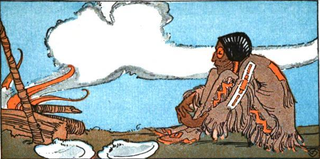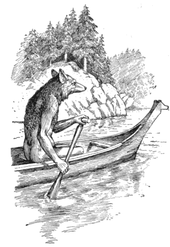
In Lakota mythology, Iktómi is a spider-trickster spirit, and a culture hero for the Lakota people. Alternate names for Iktómi include Ikto, Ictinike, Inktomi, Unktome, and Unktomi. These names are due to the differences in languages between different indigenous nations, as this spider deity was known throughout many of North America's tribes.
A culture hero is a mythological hero specific to some group who changes the world through invention or discovery. Although many culture heroes help with the creation of the world, most culture heroes are important because of their effect on the world after creation. A typical culture hero might be credited as the discoverer of fire, agriculture, songs, tradition, law, or religion, and is usually the most important legendary figure of a people, sometimes as the founder of its ruling dynasty.

The Indigenous peoples of the Americas comprise numerous different cultures. Each has its own mythologies, many of which share certain themes across cultural boundaries. In North American mythologies, common themes include a close relation to nature and animals as well as belief in a Great Spirit that is conceived of in various ways.

The Tar-Baby is the second of the Uncle Remus stories published in 1881; it is about a doll made of tar and turpentine used by the villainous Br'er Fox to entrap Br'er Rabbit. The more that Br'er Rabbit fights the Tar-Baby, the more entangled he becomes.

Nanabozho, also known as Nanabush, is a spirit in Anishinaabe aadizookaan, particularly among the Ojibwe. Nanabozho figures prominently in their storytelling, including the story of the world's creation. Nanabozho is the Ojibwe trickster figure and culture hero.

Coyote is a mythological character common to many cultures of the Indigenous peoples of North America, based on the coyote animal. This character is usually male and is generally anthropomorphic, although he may have some coyote-like physical features such as fur, pointed ears, yellow eyes, a tail and blunt claws. The myths and legends which include Coyote vary widely from culture to culture.
Spider Grandmother is an important figure in the mythology, oral traditions and folklore of many Native American cultures, especially in the Southwestern United States.
Gerald McDermott was an American filmmaker, creator of children's picture books, and expert on mythology. His creative works typically combine bright colors and styles with ancient imagery. His picture books feature folktales and cultures from all around the world.

The mythology of the Miwok Native Americans are myths of their world order, their creation stories and 'how things came to be' created. Miwok myths suggest their spiritual and philosophical world view. In several different creation stories collected from Miwok people, Coyote was seen as their ancestor and creator god, sometimes with the help of other animals, forming the earth and making people out of humble materials like feathers or twigs.
The traditional narratives of Native California are the folklore and mythology of the native people of California. For many historic nations of California, there is only a fragmentary record of their traditions. Spanish missions in California from the 18th century Christianized many of these traditions, and the remaining groups were mostly assimilated to US culture by the early 20th century. While there are sparse records from the 18th century, most material was collected during the 19th and the early 20th centuries.
The mythology of the Ohlone (Costanoan) Native American people of Northern California include creation myths as well as other ancient narratives that contain elements of their spiritual and philosophical belief systems, and their conception of the world order. Their myths describe supernatural anthropomorphic beings with the names of regional birds and animals, notably the eagle, the Coyote who is humanity's ancestor and a trickster spirit, and a hummingbird.
African-American folktales are the storytelling and oral history of enslaved African Americans during the 1700s-1900s. Prevalent themes in African-American folktales include tricksters, life lessons, heartwarming tales, and slavery. African Americans created folktales that spoke about the hardships of slavery and told stories of folk spirits that could outwit their slaveholders and defeat their enemies. These folk stories gave hope to enslaved people that folk spirits would liberate them from slavery. Folktales have been used to perpetuate negative stereotypes about the African American community. From Minstrel shows to academic journals. One of these heroes that they looked up to was the charming High John the Conqueror, who was a cunning trickster against his slave masters. He often empowered newly freed slaves, saying that if they needed him, his spirit would be in a local root. Other common figures in African-American folktales include Anansi, Brer Rabbit, and Uncle Monday. Many folktales are unique to African-American culture, while others are influenced by African, European, and Native American tales. Even today in Hip-Hop, we see the effects of African American Folklore. Tropes like Badman and Trickster have influenced the characteristics and themes seen in modern day hip hop like gangsters and pimps.

Br'er Rabbit is a central figure in an oral tradition passed down by African-Americans of the Southern United States and African descendants in the Caribbean, notably Afro-Bahamians and Turks and Caicos Islanders. He is a trickster who succeeds by his wits rather than by brawn, provoking authority figures and bending social mores as he sees fit. Popular adaptations of the character, originally recorded by Joel Chandler Harris in the 19th century, include Walt Disney Productions' Song of the South in 1946.
Peggy V. Beck is an American author known for her research on fool archetypes and ritual clowns. She has written about the Fool as a psychopomp, a guide who reveals the chaotic logic of the universe by way of creative double binds, nonsense and dreams. Her research on ritual clowns includes studies of masked figures in Africa, North America, South America and Europe. She received her PhD in the History of Consciousness in 1974 from the University of California, Santa Cruz, under the direction of Gregory Bateson, whose own work was predicated on the idea that "the lunatic, the lover, and the poet/Are of imagination all compact"1

West African mythology is the body of myths of the people of West Africa. It consists of tales of various deities, beings, legendary creatures, heroes and folktales from various ethnic groups. Some of these myths traveled across the Atlantic during the period of the Trans-Atlantic slave trade to become part of Caribbean, African-American and Brazilian mythology.

Bearheart: The Heirship Chronicles is a 1990 novel by Gerald Vizenor; it is a revised version of his 1978 debut novel Darkness in Saint Louis: Bearheart. The novel is a part of the Native American Renaissance and is considered one of the first Native American novels to introduce a trickster figure into a contemporary setting. Vizenor drew from trickster traditions from various Native American tribes, such as Nanabozho (Anishinaabe) and Kachina (Pueblo).
The origin of death is a theme in the myths of many cultures. Death is a universal feature of human life, so stories about its origin appear to be universal in human cultures. As such it is a type of origin myth, a myth that describes the origin of some feature of the natural or social world. No one type of these myths is universal, but each region has its own characteristic types. Such myths have therefore been a frequent topic of study in the field of comparative mythology.

Canadian folklore is the traditional material that Canadians pass down from generation to generation, either as oral literature or "by custom or practice". It includes songs, legends, jokes, rhymes, proverbs, weather lore, superstitions, and practices such as traditional food-making and craft-making. The largest bodies of folklore in Canada belong to the aboriginal and French-Canadian cultures. English-Canadian folklore and the folklore of recent immigrant groups have added to the country's folk.

The Hero Twins are recurring characters from the mythologies of the indigenous peoples of the Americas. The specifics of each myth vary from tribe to tribe, but each story has a pair of twins who were born when their pregnant mother was killed by the tale's antagonist. Twins were considered unnatural in many cultures of this region, with beliefs about them having supernatural abilities.













